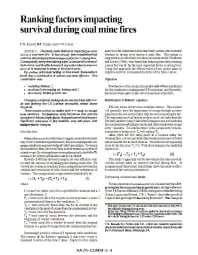Mining Publication: Ranking Factors Impacting Survival During Coal Mine Fires
Original creation date: August 1993
Authors: FN Kissell, RJ Timko, CD Litton
This study ranks the factors impacting survival during a coal mine fire. It has already been established that reducing time delays is the most important factor in saving lives. Consequently.every event during a fire is measured in terms of its duration, and the effectiveness of any action taken to improve survival is measured in terms of the time it saves. By ranking actions according to time saved. these authors found that a combination of actions was most effective. This combination was: installing lifelines; moderately decreasing air leakage; and decreasing the fire growth rate. Changing ventilation leakage alone was much less effective, as was altering the CO (carbon monoxide) sensor alarm threshold. These results confirm an earlier fault-tree study on escape from mine fires. The fault-tree study had shown that, with the exception of delays, single-factor changes have minimal impact. Significant reductions in fire fatalities only take place with multiple-factor changes.

- Analysis of Mine Fires for All U.S. Underground and Surface Coal Mining Categories: 1990-1999
- Analysis of Underground Coal Mine Fire Incidents in the United States from 1978 through 1992
- CFD Modeling of Fire Spread Along Combustibles in a Mine Entry
- Determining the Root Causes of Flame Cutting and Welding Fires in Underground U.S. Coal Mines
- Fire Response Preparedness for Underground Mines
- Mine Fire Diagnostics Applied to the Carbondale, PA Mine Fire Site
- Reducing the Fire and Explosion Hazards of Flame-Cutting and Welding in Underground Coal Mines
- The Status of Mine Fire Research in the United States
- Technology for Remote Mine Seal Construction
- An Underground Coal Mine Fire Preparedness and Response Checklist: The Instrument